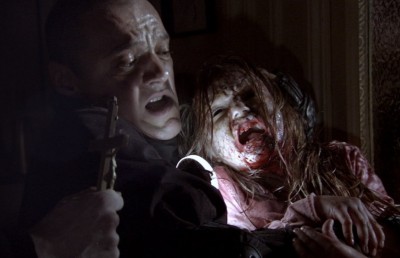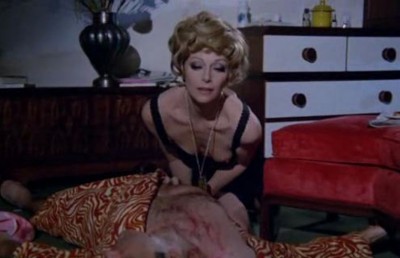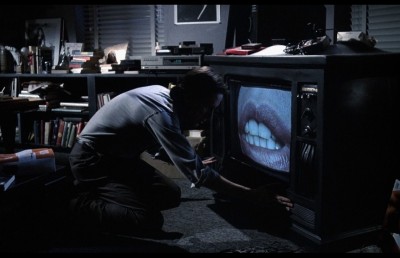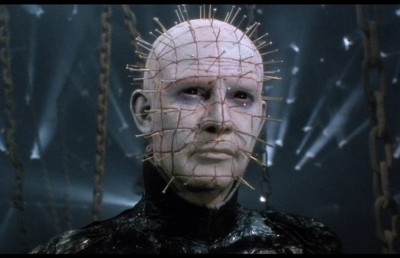The Face of Quatermass: National Identity in British Science-Fiction
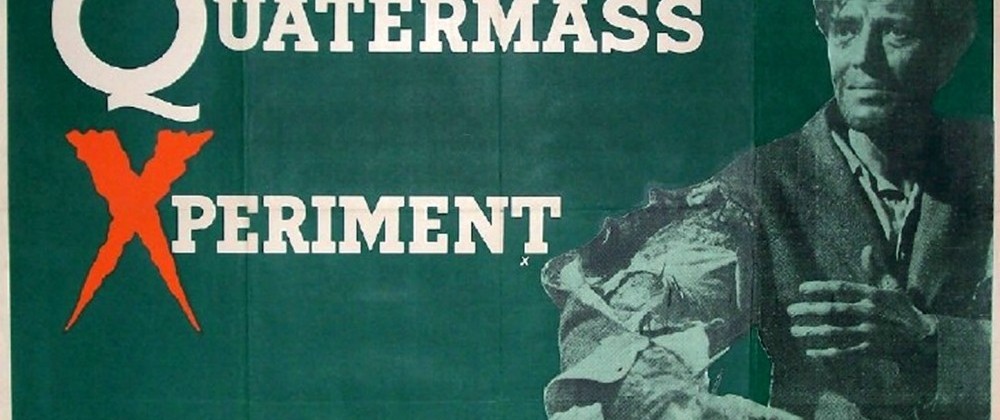
One does not have to look far beyond such modern films as Four Weddings and a Funeral, Notting Hill, Billy Elliot and The Full Monty, to find a prominent concern with defining National identity in British cinema. This is largely a product of the almost unabashed stereotyping and continual references to modern history and culture seen in British film. Without such hype of identity it would be hard to imagine someone like Hugh Grant having had such a strong career. Mike Myers in his role of Austin Powers has been acute in his address of what is distinctly and cinematically British, and in satirising our exploitation of ‘tweeness’. I have chosen to look to the 1950’s for an example of a cinema which expresses an idea of National identity that responds to cultural change and politics: Quatermass 2 (1957), made by Hammer Films Productions.
To explore this I wish to establish Hammer Productions within a context of a British filmmaking practice which involved American finance. Outlining production policies used at the studio will allow me to underscore the national references and depiction of culture and politics which I feel are being communicated. I will try to delineate the inherent differences in American and British sci-fi/horror and the climate that brought this into being. This will include interpretations of the ‘fear of invasion’ theme, the realities of a post World War existence, and relevant Global issues, the most important of these being the decline in British influence in issues of world power. From this I will offer a reading of the elements within Quatermass 2 that relate to how Britain felt about what it was/is to be British in its 1950’s post colonial phase.
The films of Hammer Films Productions rest in cinema history alongside Ealing and Gainsborough studios as a body of work which have become synonymous with British Cinema. Hammer Films Productions, or Hammer (the popular abbreviation among critics) had its own distinct qualities, in comparison to the other two, which I shall try to elaborate.
The 1920’s saw the advanced domination of American films upon the British market. Antonia Lant writes in Britain at the End of Empire [1] that American cinema was able to cover movie production costs within their home market, leaving overseas markets as profit, as well as using business practices of undercutting, block booking and blind bidding. This domination led to what became known as the ‘Black November’ of 1924, when British film production ceased. The British Government passed legislation to bring the American studios in line with the Cinematographic Films Act of 1927. The Act meant that American companies would have to finance British productions and also exhibit some of these across the Atlantic in US cinemas. The situation of the 1920’s can be seen to have established the ongoing state of finance and relations with America that the British Cinema industry has followed ever since. British studios rely on Anglo-American finance to get the majority of projects off the ground, and it was in this climate that Hammer productions first appeared.
Registered in 1934 by Exclusive Films, Hammer Productions Ltd. was set up to produce ‘support films’ for the American films that their parent company were distributing in Britain. The amount and prominence of Hammer Productions at this time was minimal, but this was to change after the Second World War, when Colonel James Carreras was put in as Managing Director by his father Enrique. It was James Carreras’ prudence in streamlining the finance of their productions that would establish Hammer as a success story with regards to output and profits.
The first policy, with which Hammer had succeeded financially, was to make cinematic adaptations of radio and television series’. It was a policy which would secure a guaranteed financial success to investors, based on the popularity of the original text. David Pirie, in his account of Hammers origins, names; PC 49, The Man in Black, Life with the Lyons and Dick Barton. The Hammer studios trilogy of Quatermass films was such an investment, with the original BBC scriptwriter, Nigel Kneale, being involved. The success of the BBC screening of The Quatermass Experiment (1955) contains an interesting paradox. It came at a time, the 1950’s, when television viewing would start to undermine cinema audiences, especially with the introduction of commercial channels (ITV); it is an interesting irony to see the continuation of cinema’s existence being fed from one of its main competitors. This approach to bankable film productions still continues with films such as The Sweeney, On the Buses, Bean and Kevin and Perry Go Large. By concentrating on these adaptations, Hammer was establishing its own take on highly nationalised texts. The content of the original Quatermass Experiment broadcasts had been specifically created for a home market, but now Hammer was to take them beyond those shores.
Like all British film production, Hammer had to make some allowances for the Anglo-American partnership which fuelled the industry. This would take shape in the form of American actors taking the lead role, exemplified by the casting of Brian Donlevy as Professor Quatermass in the first two Quatermass adaptations, when the original casting in the television series was that of a British actor. It needs to be foregrounded that although there may be an American lead present in Quatermass 2 (1957), it makes no fundamental change to the national context and identification; the Americanisation within the cast is mere window dressing, which leaves the depiction of society and politics relatively unscathed. No reference is made of Prof. Quatermass’s nationality within the film, unlike –for example– the Canadian origins of Hollywood actor Robert Preston’s character in Cloudburst (1952).
Shrewd financial policy was to also enrich Hammer films with a visual aesthetic inherent to its British home, Bray Studios:
Between 1948 and 1950 Hammer moved its production base several times from one large country house to another. The decision to use country houses rather than studios was determined by cost factors, and it proved to be one of the company’s most important policy decisions, for it gave the films a distinctive style. [2]
This ‘distinctive style’ can be seen interpreted in the first two Quatermass movies as the country locations which open both films. As Peter Hutchings writes, The Quatermass Xperiment opens with the surreal scene of a space capsule crashed next to a remote country house, which is complimented by the country location of the near road crash, which brings the threat to Quatermass’s attention in the second film. It is important to mention that the contrast in locations in Quatermass 2 of countryside and Oil refinery relates to issues of identity, but at this point it is enough to mention the use of the British landscape as a convention and aesthetic backdrop to the narrative:
What is helpful at this stage is to think about British horror films as being part of a British national cinema, where this cinema is simultaneously a cultural and an economic institution which, in Geoffrey Nowell-Smith’s words “in some way signifies itself to its audiences as the cinema through which the country speaks.” [3]
With the success of The Quatermass Xperiment, Hammer was quick to acknowledge the horror and science fiction genre as a direction worth following. Like other productions, The Quatermass Xperiment was a remake, but this time of a successful television series commissioned by the BBC, The Quatermass Experiment (1953). The title change was made to cash in on the X certificate that it was assigned by the censors. [4] The Hammer film version was so successful at the box office that the television sequel Quatermass 2, which was broadcast in 1955, was also remade in 1957. Hammer Productions had struck a chord with a cinematic trend that was developing in Hollywood: the horror genre, and at this time in particular the hybrid science-fiction/horror genre (or sci-fi as it is sometimes labelled for short). David Pirie in his research into Hammer points out a marked trend in the 1950’s for a move away from ‘family entertainment,’ and towards ‘emphatically sensational matter.’ [5] He explains this as the cinema’s battle against television, with the big screen being able to provide content that went beyond what was possible on television (graphic violence, sexual titillation). The economically conscious Hammer would become recognised world-wide over the next twenty years for its horror output that exploited this ‘big screen’ content.
Peter Hutchings’ work on British Horror provides some interesting answers to the differences between American and British films of the genre. As others have also noted, [6] it is natural for the codes and conventions of a genre to evolve and change. Which meant that there was plenty of scope within horror for the British to add their own twist, alongside that of such contemporaries as the Americans (Roger Corman) and the Italians (Mario Bava). These differences are both filled and fuelled by the socio-historical context of the respective nation. In other words, the genre takes on sources and inspiration from the national climate and attitudes prior to and during its making, which allows the indigenous audience to relate to common notions of anxiety and fear; which, theoretically, should allow for widespread audience association and subsequent box office success.
Hutchings also addresses the fact that the specific British aesthetics and ideologies expressed are not misread by an American audience, but rather that this secondary audience reads the film in terms of their own national cultures. In the 1950’s the core of the horror genre was the sci-fi/horror film and following Hutchings work one can unravel the core socio-historical issues present at the time of construction. Sci-fi/horror of the 50’s was seen as a direct product of Cold War paranoia created by global events after the Second World War:
The countries of the world were decamping into ideological territories, aided by the emergent superpowers: the United States and the USSR. The bogeyman of communism was hiding under every bed. The prospect of war still tantilized. And television was on hand to remind that while life in general may have begun to look increasingly good, never before had man seemed so mortal as he did, when over him hung the appalling spector of the hydrogen bomb. [7]
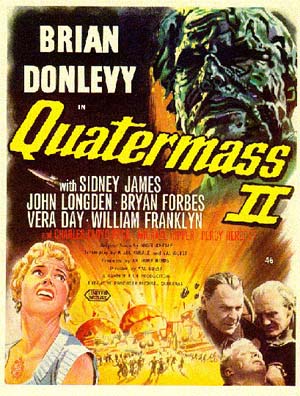
This extract exemplifies the general understanding of how Sci-fi/horror fit into the Western worlds’ consumption of entertainment and its cultural influence common to most of these nations. It has been said that American films such as The Thing from Another Planet (1951) and Invasion of the Body Snatchers (1955) were products of the tensions within society to come to terms with new scientific technology, and the threat of ideological invasion. McCarthyism was to play a huge part in creating a climate of ‘paranoia’ in America, which one can read into the threat in Invasion of the Body Snatchers as a war fought for the minds of the people. In these paranoia scenarios communism could attack the family and community directly, undermining the American way of life by taking over people’s minds and bodies, eliminating individuality and replacing it with a homogenous society of slave workers. It would be all-too convenient when writing about the dominant Hollywood tradition of sci-fi/horror to assume the same of its British counterpart, but as I. Q. Hunter writes, this is not the case. Instead Hunter concludes that the focus of the British sci-fi/horror film is based more on the ‘tensions of post-war consensus than with metaphors of Red invaders’. [8] This is not to say that Britain did not have any concern over Russia, on the contrary: ‘By the end of the 1940’s the British government regarded the Soviet Union as actively promoting revolution on a worldwide basis, and in particular as having ambitions to take over much of Europe by military force or political infiltration.’ [9]
It was paranoia that both the American and British films used as fear in their themes, but it is in the focus of this paranoia that one can find difference. The fear of invasion is the common threat throughout sci-fi/horror at this time: aliens coming from outer space to colonise our planet. It was seen as the dominant metaphor for the communist threat, but in Quatermass 2, unlike its American counterparts, the threat was less isolated and exterior, but rather interior. To make this point clear, it is important to look more closely at Invasion of the Body Snatchers and Quatermass 2, both of which have a comparable element of people’s corpses being taken over by an alien sentient being. In Invasion of the Body Snatchers the physical form of the victim is replaced by another body that is shaped to look exactly the same as the ‘original,’ whilst in Quatermass 2 the body of the victim remains, but is breached by an alien consciousness, taking the victim as host. The victim is still the same person, but not in mind. The second point to note is that in Invasion of the Body Snatchers the threat has only just begun, and the invasion is fresh and isolated; it is still relatively outside the core of the American social and political structure. It is taking its first victims on the outskirts of political, economic and military importance. In Quatermass 2 the invasion has a strong foothold within British structure; the narrative reveals a two year period of infiltration that strikes deep in Whitehall. The invasion threat is a cancer already growing within British government, creating legislation and taking actions to benefit their (the aliens) plans.
The paranoia expressed within Quatermass 2 can be read as a distrust of the British government and also that of a national identity crisis. David Pirie cites the Suez Crisis of the 50’s as being the epitome of the attitude of the government in Britain. The Suez Crisis itself embodies a flailing post WW2 mentality coming face to face with the modern reality of Cold War superpower conflict of interests.
…I think it is true that Eden judged the Suez Canal episode as being more or less the exact equivalent of the Rhineland occupation by Hitler, which was exactly 20 years before. (William Clark, Eden’s Public Relations Adviser) [10]
The year 1956 saw the French, Israeli and British government launch an attack on the Egyptian forces. The British involvement in this conflict was exclusively to do with the nationalisation of the Suez Canal, which was a major cargo route to Europe, especially for oil. Prime Minister Anthony Eden accused the Egyptian president Nasser of being a new ‘little Hitler’ and took great personal interest in the issue, which resulted in a conflict that lasted less than a fortnight. The reason for the sudden resolution was due to a new global power situation that had appeared in the post-war period, with the two superpowers, America and USSR, whose positions of power would be tested by Britain. The posturing of both cold war rivals behind the two sides in the Suez crisis had meant that Britain and allies had to back down, to tow the line to America’s bidding. This vision of global impotence for Britain was shocking and in Robert Hewison’s book In Anger, had a huge effect on British society. It had begun to dawn on Britain that it was not the great and mighty colonial power that had inspired the nation’s myths; this was something of an identity crisis.
Another question had arisen from the Suez Crisis, ‘who was in control of the country?’. Whilst America could be seen to have a strong position and zealous leader (Dwight D. Eisenhower), Britain was left in a post-war daze, with a infirm leader in Eden. Taking this statement one can apply this to our text Quatermass 2, continuing on from the reading earlier about the nature of the invasion threat.
The alien invasion in Quatermass 2 had been infiltrating the government and vital strategic positions for over two years. Professor Quatermass was to discover that his plans for a technologically advanced moon colony had been developed without his attendance. Was this a manifestation of the growing Cold war paranoia in Britain, shaped by its governments inability to have any power in global affairs? In an interview with the original scriptwriter, Nigel Kneale had this to say:
It was a period when lots of mysterious radar establishments and places of that sort had been built across the counties, and if anything it was done with even greater secrecy than it would be now, because there was a great nervousness in the country. People were frightened of what might drop from the skies, and they didn’t want to ask too much about what was going on. [11]
Professor Quatermass’s role in the film was that of the British Rocket team, leading his nation’s development of new scientific technologies. This fact that his position is usurped could be read as Britain’s own fears about scientific achievement. Britain was having to face succession in the space race by America and having to fight for the ability to develop atomic technology, and be a nuclear power. Does Quatermass epitomise this position for Britain? Obviously the 1950’s sci-fi/horror had been charged by the development of nuclear power, and this became the reason for all kinds of man-made disasters and victories. Britain had poignant memories of the destruction during the Blitz, therefore the results of nuclear war were not difficult for the population to imagine. This time in history saw the start of CND, Campaign for Nuclear Disarmament, which was a reaction to the possibility of a war fought with atomic weaponry.
One can draw on I. Q. Hunter’s writing for theories of the influence of the Blitz upon British sci-fi/horror films, when he mentions a preoccupation with seeing London being destroyed. It is not hard to see that the war was still fairly fresh in the minds of the public. Rationing was still in effect during the early 1950’s and turning the war army back into civilians was not a quick process. The damage that had taken place during the war was leaving scars across the country, again these did not disappear overnight. Prof. Quatermass’ comments on the remains of a village he finds on Winnerton Flats, lost to the moon colony site, is extremely evocative of the Blitz damage. While the bomb-like shape of the seed pods in Quatermass 2 are eerily reminiscent of the German bombing raids.
The spectre of the war seems implicit in the script of Quatermass 2. Peter Hutchings notes such with reference to the Camp Community which runs the worker’s housing area for the Moon base/plant. When Prof. Quatermass enters the community hall he is met with posters instilling the benefits of ‘sealed lips’; his surroundings would not have been out of place ten years earlier. The attitude of the Camp Community is that of pride in devotion to the production of ‘synthetic foods,’ which harks back to war production nostalgia. With rationing only just ending it is interesting to note that the cover for the plant is the manufacture of ‘synthetic food,’ an indication of post-war recovery.
It becomes evident that within the story of Quatermass 2 there is considerable political commentary. Not just the generalised comment on the global position of Britain, but also on the post-colonial inversion that seemed to be taking place. One takes the lead from Peter Hutchings again, when he points out that unlike the American genre films, Quatermass 2 does not involve itself with any central romance. In both The Thing and Invasion of the Body Snatchers the lead male role is set up with a love interest within the first twenty minutes of screen time. This is blatantly missing in Quatermass 2, where Prof. Quatermass’s personality is clearly disinterested in such matters. What does this mean to the focus of the story and its dealings? Once again Hutchings’ writing on the matter theorises that the “tendency to view individuals as primarily within and in relation to groups, institutions and collectives” [12] is a product of the collective national identity created through war propaganda. Hutchings links the dissolution of working class families due to the Depression to the post-war dislocation of family structure, and to this end finds the social uprising ‘shocking’ for its time of release. One must say that the scenes of the workers rising up against their alien masters is reminiscent of Eisenstein’s films. The theory of political unrest amongst the classes is bolstered by the character of Vinnie Broadhead MP, his common accent slipping through every time he refers to his name and his mission to make those in power responsible to the populace. One can see Broadhead as the working class champion. He is desperate to see what is taking place on Winnerton Flats and communicates this to Prof. Quatermass with the utmost fervour. Broadhead constantly broadcasts a uncompromising attack on bureaucracy, and his demise –he is killed when he falls into a storage tank on the plant which contains an ammonia like substance– can be seen as a metaphorical warning against insurgent behaviour.
Much can be read into the anxieties and fears identified within the genre of sci-fi/horror, especially the British entries in this genre, and specifically Quatermass 2. It may appear foolish to take any reading at face value, without considering the conscious effort that has taken place to ‘fit’ socio-historical events to the narrative. It is also wrong to think that the environment at the time would not have had an effect on the story and influenced its content. However, I do perceive Quatermass 2 as an acute indicator of the times and events taking place in Britain in the 1950’s. It was clear to me upon reading an interview with the writer Nigel Kneale that he was attempting to encode as much of the atmosphere in Britain as he could, and this is what, in my opinion, made the film and its prequel and sequel, so popular.
I would also like to suggest two possible counter-readings of the above symbolic nature of the alien invasion. The first being that the aliens are symbolic of Americanisation. Unlike Britain, which was relinquishing its commonwealth and shrinking in physical size, America was expanding, through cultural imperialism, global power and the space race (as was USSR). It is in space that the Americans beat the British and adopted the mentality of colonialism and prosperity. Prof. Quatermass, his actor’s nationality aside, stands for Britain’s hope of scientific advance, to counter the Empire’s decline. The second reading I have for the aliens is an inward one. In a very cathartic fashion the alien invasion can be seen as mimicking the colonisation that Britain had achieved in its own history. At the time of Quatermass 2, Britain was granting independence to much of its realm, alongside the Dutch and the French, over the period of 1945-60. Was the narrative of invasion a realisation of the effects of colonialism, and a taste of our own medicine?
I have attempted to explain how Quatermass 2 expresses many ideas about national identity. The film not only represents Britain at the time of the Cold War and the threat of nuclear attack, but also describes internal anxieties regarding the Second World War and future prosperity. It is in my opinion that Quatermass 2 is inherently political, for it even comments on worker’s rights to protest, with the uprising at the moon base/plant. This I believe relates to the power of strike, which was only granted back to the unions in the 1950’s, after being withdrawn during the war. David Pirie mentions the Trade Unions in his work on the social climate in Britain and that they may have influenced the popularity of horror. Pirie remarks that ‘April and May 1955 saw some of the most important and widespread industrial disputes in Britain since before the war’, [13] which led to a press reaction of ‘horror’. [14] It has been noted that an ideal way to express ideas of society, politics and philosophy is by employing hypothetical situations through such fiction as science fiction, as has been copiously noted about George Orwell’s classic dystopian novel 1984. I feel that Quatermass 2 is following in this long-standing tradition.
Endnotes
1 Nowell-Smith, p.361
2 Cook & Bernick, p.85
3 Hutchings, p.15
4 “The X certificate was introduced by the British Board of Film Censors in 1951, following the recommendations of the Wheare Committee report. It replaced and extended the remit of the H certificate, which largely covered horror films.” Screenonline. Accessed July 28, 2008.
5 Pirie, p.26
6 John G Cawelti called it ‘convention and invention’ in his excellent book The Six-Gun Mystique. Bowling Green Ohio: Bowling Green University Popular Press, p. 28.
7 Meikle, p.xiv-xv
8 Hunter, p.1
9 Madgwick, Steeds and Williams, p.264
10 Ibid, p356, extract reprinted in The Listener, 22 Nov., 1979
11 Hunter, p.53
12 Hunter, p.39
13 Pirie, p.38
14 Ibid
Bibliography
Hewison, Robert, In Anger, Culture in the Cold war 1945-1960. London, Weidenfeld & Nicholson, 1981.
Hunter, I. Q. (ed), British Science Fiction Cinema. London: Routledge, 1999.
Hunter, Jack (ed), House of Horror, The Complete Hammer films story. London: Creation Books, 1995.
Hutchings, Peter. Hammer and Beyond: The British horror film. Manchester: Manchester Uni. Press, 1993.
Madgwick, P. J., D. Steeds and L. J. Williams, British Since 1945. London: Hutchinson, 1986.
Meikle, Denis, A History of Horrors, The Rise and Fall of the House of Hammer. London: The Scarecrow Press, 1996.
Nowell-Smith, Geoffrey (ed), The Oxford History to World Cinema. Oxford: Oxford University Press, 1997.
Pirie, David, A Heritage of Horror (London, 1972)
Filmography
Invasion of the Body Snatchers, (USA, dir. Don Sigel, 1955)
The Thing (from another world), (USA, dir. Christian Nyby, 1951)
Quatermass 2, (UK, dir. Val Guest, 1957)
Quatermass and the Pit, (UK, dir. Roy Ward Baker, 1967)


